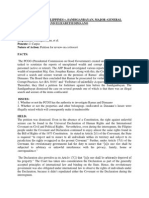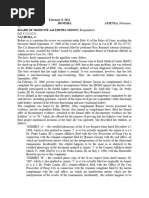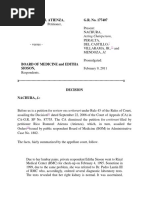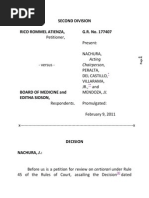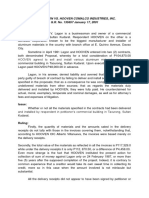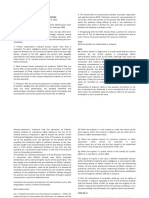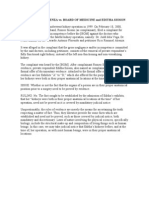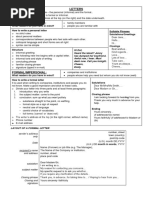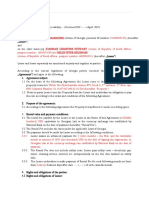Formal Offer of Exhibits - Procedure
Formal Offer of Exhibits - Procedure
Uploaded by
Bey VillanuevaCopyright:
Available Formats
Formal Offer of Exhibits - Procedure
Formal Offer of Exhibits - Procedure
Uploaded by
Bey VillanuevaOriginal Title
Copyright
Available Formats
Share this document
Did you find this document useful?
Is this content inappropriate?
Copyright:
Available Formats
Formal Offer of Exhibits - Procedure
Formal Offer of Exhibits - Procedure
Uploaded by
Bey VillanuevaCopyright:
Available Formats
ATIENZA VS BOARD OF MEDICINE (BOM)
G.R. No. 177407
February 9, 2011
Due to her lumbar pains, private respondent Editha Sioson went to Rizal
Medical Center (RMC) for check-up on February 4, 1995. Sometime in
1999, due to the same problem, she was referred to Dr. Pedro Lantin III of
RMC who, accordingly, ordered several diagnostic laboratory tests. The
tests revealed that her right kidney is normal. It was ascertained, however,
that her left kidney is non-functioning and non-visualizing. Thus, she
underwent kidney operation in September, 1999.
On February 18, 2000, private respondents husband, Romeo Sioson (as
complainant), filed a complaint for gross negligence and/or incompetence
before the [BOM] against the doctors who allegedly participated in the
fateful kidney operation, namely: Dr. Judd dela Vega, Dr. Pedro Lantin, III,
Dr. Gerardo Antonio Florendo and petitioner Rico Rommel Atienza.
It was alleged in the complaint that the gross negligence and/or
incompetence committed by the said doctors, including petitioner, consists
of the removal of private respondents fully functional right kidney, instead
of the left non-functioning and non-visualizing kidney.
The complaint was heard by the [BOM]. After complainant Romeo Sioson
presented his evidence, private respondent Editha Sioson, also named as
complainant there, filed her formal offer of documentary evidence.
Attached to the formal offer of documentary evidence are her Exhibits A to
D, which she offered for the purpose of proving that her kidneys were both
in their proper anatomical locations at the time she was operated. She
described her exhibits, as follows: (EXHIBIT A, B, etc.)
Petitioner filed his comments/objections to private respondents [Editha
Siosons] formal offer of exhibits. He alleged that said exhibits are
inadmissible because the same are mere photocopies, not properly
identified and authenticated, and intended to establish matters which are
hearsay. He added that the exhibits are incompetent to prove the purpose
for which they are offered.
The formal offer of documentary exhibits of private respondent [Editha
Sioson] was admitted by the [BOM] per its Order dated May 26, 2004. It
reads:
The Formal Offer of Documentary Evidence of [Romeo Sioson], the
Comments/Objections of [herein petitioner] Atienza, [therein respondents]
De la Vega and Lantin, and the Manifestation of [therein] respondent
Florendo are hereby ADMITTED by the [BOM] for whatever purpose they
may serve in the resolution of this case.
Let the hearing be set on July 19, 2004 all at 1:30 p.m. for the reception of
the evidence of the respondents.
SO ORDERED.
Petitioner moved for reconsideration of the abovementioned Order
basically on the same reasons stated in his comment/objections to the
formal offer of exhibits.
The [BOM] denied the motion for reconsideration of petitioner in its Order
dated October 8, 2004. It concluded that it should first admit the evidence
being offered so that it can determine its probative value when it decides
the case. According to the Board, it can determine whether the evidence is
relevant or not if it will take a look at it through the process of admission. x
x x.[3]
Disagreeing with the BOM, and as previously adverted to, Atienza filed a
petition for certiorari with the CA, assailing the BOMs Orders which
admitted Editha Siosons (Edithas) Formal Offer of Documentary Evidence.
The CA dismissed the petition for certiorari for lack of merit.
Petitioner argues that the exhibits formally offered in evidence by Editha:
(1) violate the best evidence rule; (2) have not been properly identified and
authenticated; (3) are completely hearsay; and (4) are incompetent to
prove their purpose. Thus, petitioner contends that the exhibits are
inadmissible evidence.
Admissibility of evidence refers to the question of whether or not
the circumstance (or evidence) is to be considered at all. On the
other hand, the probative value of evidence refers to the
question of whether or not it proves an issue.
You might also like
- 'A' Level Sociology Study PackDocument114 pages'A' Level Sociology Study PackAngeline Munodawafa100% (5)
- Waiver Release and Quitclaim - Vehicular Accident (Sample)Document2 pagesWaiver Release and Quitclaim - Vehicular Accident (Sample)Bey Villanueva88% (8)
- Atienza v. Board of Medicine (Digest)Document3 pagesAtienza v. Board of Medicine (Digest)Tini Guanio80% (5)
- Libel - Case LawDocument9 pagesLibel - Case LawBey VillanuevaNo ratings yet
- Grave Coercion - JurisprudenceDocument6 pagesGrave Coercion - JurisprudenceBey Villanueva100% (1)
- Defenses - LibelDocument7 pagesDefenses - LibelBey VillanuevaNo ratings yet
- Republic of The Philippines, 407 SCRA 10-DIGESTEDDocument2 pagesRepublic of The Philippines, 407 SCRA 10-DIGESTEDPilyang Sweet92% (13)
- Cases in EvidenceDocument377 pagesCases in EvidenceMai ReamicoNo ratings yet
- Rico Rommel Atienza Vs Board of MedicineDocument3 pagesRico Rommel Atienza Vs Board of Medicinecherry_romano_2No ratings yet
- CASE1Document64 pagesCASE1miggyacasasNo ratings yet
- Medical Malpractice CasesDocument95 pagesMedical Malpractice CasesfclalarilaNo ratings yet
- 1st Part Cases EvidenceDocument61 pages1st Part Cases EvidenceSonnyNo ratings yet
- Evidence Rule 128: RICO ROMMEL ATIENZA, Petitioner, Board of Medicine and Editha Sioson, G.R. No. 177407Document45 pagesEvidence Rule 128: RICO ROMMEL ATIENZA, Petitioner, Board of Medicine and Editha Sioson, G.R. No. 177407Jheiy-em EvangelistaNo ratings yet
- G.R. No. 177407 February 9, 2011 RICO ROMMEL ATIENZA, Petitioner, Board of Medicine and Editha Sioson, RespondentsDocument4 pagesG.R. No. 177407 February 9, 2011 RICO ROMMEL ATIENZA, Petitioner, Board of Medicine and Editha Sioson, RespondentsJay B. Villafria Jr.No ratings yet
- Evidence 1-20 Fulltext CasesDocument187 pagesEvidence 1-20 Fulltext CasesJed M. De LeonNo ratings yet
- Atienza v. Board of Medicine, G.R. No. 177407, February 9, 2011Document6 pagesAtienza v. Board of Medicine, G.R. No. 177407, February 9, 2011Raphael Antonio PunzalanNo ratings yet
- Atienza Vs Board of Medicine G.R. No. 177407.Document4 pagesAtienza Vs Board of Medicine G.R. No. 177407.Soc SaballaNo ratings yet
- Case Digest Evidence Atienza V Bom JK NavarroDocument2 pagesCase Digest Evidence Atienza V Bom JK NavarroJaymar DetoitoNo ratings yet
- Atienza Vs Board of MedicineDocument9 pagesAtienza Vs Board of MedicineLolengCarandangNo ratings yet
- Rico Rommel Atienza, Petitioner, vs. Board of Medicine and Editha Sioson, RespondentsDocument8 pagesRico Rommel Atienza, Petitioner, vs. Board of Medicine and Editha Sioson, RespondentsAngelie FloresNo ratings yet
- Evidence Rule 128: RICO ROMMEL ATIENZA, Petitioner, G.R. No. 177407Document33 pagesEvidence Rule 128: RICO ROMMEL ATIENZA, Petitioner, G.R. No. 177407Jheiy-em EvangelistaNo ratings yet
- Atienza Vs BOD of MedicineDocument10 pagesAtienza Vs BOD of MedicineNoelle Therese Gotidoc VedadNo ratings yet
- Atienza vs. Board of Medicine, G.R. No. 177407, February 9, 2011 G.R. No. 177407Document5 pagesAtienza vs. Board of Medicine, G.R. No. 177407, February 9, 2011 G.R. No. 177407Aprilyn CelestialNo ratings yet
- Atienza Vs BOM - Evidence CaseDocument2 pagesAtienza Vs BOM - Evidence CaseChristine JoyNo ratings yet
- Atienza VS Board of Medicine - Case DigestDocument4 pagesAtienza VS Board of Medicine - Case DigestSushane BituinNo ratings yet
- Rico Rommel Atienza vs. Board of Medicine, GR No. 177407, 9 February 2011 DigestDocument2 pagesRico Rommel Atienza vs. Board of Medicine, GR No. 177407, 9 February 2011 DigestAbilene Joy Dela CruzNo ratings yet
- Atienza V Board of MedicineDocument4 pagesAtienza V Board of MedicineKatrina GamboaNo ratings yet
- Second Division Rico Rommel Atienza, G.R. No. 177407: ChairpersonDocument15 pagesSecond Division Rico Rommel Atienza, G.R. No. 177407: ChairpersonBianca BeltranNo ratings yet
- Atienza vs. Board of MedicineDocument8 pagesAtienza vs. Board of MedicinejNo ratings yet
- GR No. 177407 - DigestDocument2 pagesGR No. 177407 - DigestLeopoldo, Jr. Blanco100% (1)
- ATIENZA Vs Board of MedicineDocument2 pagesATIENZA Vs Board of MedicineRosalie Castro100% (2)
- Atienza v. Board of Medicine FactsDocument2 pagesAtienza v. Board of Medicine FactsWhere Did Macky GallegoNo ratings yet
- Logic Case DigestDocument22 pagesLogic Case DigestShammah Rey MahinayNo ratings yet
- Legal Techniques and Logic Digested CaseDocument16 pagesLegal Techniques and Logic Digested CaseAprilRoseGonzalVitalNo ratings yet
- Biedron v. Anonymous Physician 1 - 2018 Ind. App. LEXIS SJ AffidavitsDocument15 pagesBiedron v. Anonymous Physician 1 - 2018 Ind. App. LEXIS SJ AffidavitsCourt FanaticNo ratings yet
- 1 - Atienza V Board of MedicineDocument5 pages1 - Atienza V Board of MedicineMarione ThiamNo ratings yet
- Atienza vs. Board of MedicineDocument12 pagesAtienza vs. Board of MedicineAnonymousNo ratings yet
- Atienza Vs Board of MedicineDocument1 pageAtienza Vs Board of MedicinealdinNo ratings yet
- 04 Atienza v. Board of MedicineDocument3 pages04 Atienza v. Board of MedicinePatricia SulitNo ratings yet
- Case No. 1 Atienza V Board of Medicine FactsDocument56 pagesCase No. 1 Atienza V Board of Medicine FactsRoyalhighness18No ratings yet
- Rico Rommel Atienza vs. Board of Medicine and Editha SiosonDocument1 pageRico Rommel Atienza vs. Board of Medicine and Editha SiosonMamito KampitanNo ratings yet
- Atienza DigestDocument1 pageAtienza DigestMary Grace SevillaNo ratings yet
- Order of Suppression - in Re Herrera-Priego (N.Y. Imm. CT, July 10, 2003) (IJ Lamb)Document25 pagesOrder of Suppression - in Re Herrera-Priego (N.Y. Imm. CT, July 10, 2003) (IJ Lamb)J CoxNo ratings yet
- DigestDocument30 pagesDigestArt DemitNo ratings yet
- Evidence CasesDocument31 pagesEvidence CasesJernel JanzNo ratings yet
- 63ethics. Amatorio v. YapDocument9 pages63ethics. Amatorio v. YapHomer SimpsonNo ratings yet
- Atienza Vs Board of MedicineDocument10 pagesAtienza Vs Board of MedicineCristineNo ratings yet
- GR No. 177407, Atienza vs. Board of Medicine, SiosonDocument9 pagesGR No. 177407, Atienza vs. Board of Medicine, SiosonLeopoldo, Jr. BlancoNo ratings yet
- Design Sources International V Eristingcol G.R. 193966Document5 pagesDesign Sources International V Eristingcol G.R. 193966Dino Bernard LapitanNo ratings yet
- ATIENZA V BOARD OF MEDICINEDocument2 pagesATIENZA V BOARD OF MEDICINEChilzia RojasNo ratings yet
- INEABELLES CIRINO-ENCARNACIÓN v. CONCILIO DE SALUD INTEGRAL DE LOIZA, INC. HÉCTOR M. CABÁIN-HERNÁINDEZ, 317 F.3d 69, 1st Cir. (2003)Document5 pagesINEABELLES CIRINO-ENCARNACIÓN v. CONCILIO DE SALUD INTEGRAL DE LOIZA, INC. HÉCTOR M. CABÁIN-HERNÁINDEZ, 317 F.3d 69, 1st Cir. (2003)Scribd Government DocsNo ratings yet
- San Agustin vs. Sales G.R. No. 189289Document7 pagesSan Agustin vs. Sales G.R. No. 189289Import Back upNo ratings yet
- Ledesma V CA GR No. 161629Document7 pagesLedesma V CA GR No. 161629Denise CruzNo ratings yet
- Atienza v. Board of Medicine/ESCRADocument13 pagesAtienza v. Board of Medicine/ESCRAMaria Francheska GarciaNo ratings yet
- Atienza vs. BOM and SiosonDocument2 pagesAtienza vs. BOM and SiosonCaitlin KintanarNo ratings yet
- Atienza v. Board of MedicineDocument13 pagesAtienza v. Board of Medicinemceline19No ratings yet
- 2019 2020 Evidence Batch 1 Case Digests PelaezDocument16 pages2019 2020 Evidence Batch 1 Case Digests PelaezjumpincatfishNo ratings yet
- Stone v. Instrumentation Laboratory Co., 591 F.3d 239, 4th Cir. (2009)Document20 pagesStone v. Instrumentation Laboratory Co., 591 F.3d 239, 4th Cir. (2009)Scribd Government DocsNo ratings yet
- Yu v. YukayguanDocument11 pagesYu v. YukayguanbearzhugNo ratings yet
- Case Digest - Oropesa Vs OropesaDocument2 pagesCase Digest - Oropesa Vs OropesaMaricris GalingganaNo ratings yet
- Problem Areas in Legal Ethics First Exam Atty. Ivy B. LuricaDocument7 pagesProblem Areas in Legal Ethics First Exam Atty. Ivy B. LuricaKathNo ratings yet
- Third Division G.R. No. 177549, June 18, 2009: Chico-Nazario, J.Document41 pagesThird Division G.R. No. 177549, June 18, 2009: Chico-Nazario, J.Maria Nicole VaneeteeNo ratings yet
- G.R. No. 184528 April 25, 2012 NILO OROPESA, Petitioner, CIRILO OROPESA, RespondentDocument44 pagesG.R. No. 184528 April 25, 2012 NILO OROPESA, Petitioner, CIRILO OROPESA, RespondentmgeeNo ratings yet
- An Appeal to the U.S Supreme Court & A Proposal to Our PresidentFrom EverandAn Appeal to the U.S Supreme Court & A Proposal to Our PresidentNo ratings yet
- Perjury - VenueDocument2 pagesPerjury - VenueBey VillanuevaNo ratings yet
- Prescriptive PeriodDocument2 pagesPrescriptive PeriodBey Villanueva100% (1)
- Qualified Theft - NOTESDocument2 pagesQualified Theft - NOTESBey Villanueva100% (1)
- Contempt - JurisprudenceDocument2 pagesContempt - JurisprudenceBey VillanuevaNo ratings yet
- Online Libel Can Be Prosecuted in Our Local Courts Pursuant To The Cybercrime ActDocument2 pagesOnline Libel Can Be Prosecuted in Our Local Courts Pursuant To The Cybercrime ActBey VillanuevaNo ratings yet
- Term or Fixed EmploymentDocument2 pagesTerm or Fixed EmploymentBey VillanuevaNo ratings yet
- JurisdictionDocument3 pagesJurisdictionBey VillanuevaNo ratings yet
- Bail - RequirementsDocument1 pageBail - RequirementsBey VillanuevaNo ratings yet
- Libel Defenses - JurisprudenceDocument16 pagesLibel Defenses - JurisprudenceBey Villanueva100% (1)
- Indirect Contempt NotesDocument6 pagesIndirect Contempt NotesBey Villanueva100% (1)
- ESTAFA - JurisprudenceDocument1 pageESTAFA - JurisprudenceBey VillanuevaNo ratings yet
- Writ of Preliminary Injuction/Tro China Banking Corporation vs. Ciriaco G.R. No. 170038 July 11, 2012Document4 pagesWrit of Preliminary Injuction/Tro China Banking Corporation vs. Ciriaco G.R. No. 170038 July 11, 2012Bey Villanueva100% (1)
- Libel NotesDocument2 pagesLibel NotesBey VillanuevaNo ratings yet
- Rescission - JurisprudenceDocument4 pagesRescission - JurisprudenceBey Villanueva100% (1)
- JURISPRUDENCE - General Vs SpecificDocument4 pagesJURISPRUDENCE - General Vs SpecificBey VillanuevaNo ratings yet
- Special Power of Attorney: OFFICE To Be My True and Lawful Attorney-In-Fact, To Appear For andDocument2 pagesSpecial Power of Attorney: OFFICE To Be My True and Lawful Attorney-In-Fact, To Appear For andBey VillanuevaNo ratings yet
- Affidavit of Loss: AbcdeDocument1 pageAffidavit of Loss: AbcdeBey VillanuevaNo ratings yet
- Application For ProbationDocument2 pagesApplication For ProbationBey VillanuevaNo ratings yet
- Formal-Informal LettersDocument1 pageFormal-Informal LettersAnikó SkribekNo ratings yet
- International Journal On Cryptography and Information Security (IJCIS)Document2 pagesInternational Journal On Cryptography and Information Security (IJCIS)ijcisjournalNo ratings yet
- X - Thoughts On Robert Sepehr - Paranormal - 4chanDocument5 pagesX - Thoughts On Robert Sepehr - Paranormal - 4chanAnonymous dIjB7XD8Z100% (1)
- English Agreement Axis 75Document4 pagesEnglish Agreement Axis 75Мар КаNo ratings yet
- Boredom and Whoredom - Reading Renaissance Women's Sonnet SequencesDocument27 pagesBoredom and Whoredom - Reading Renaissance Women's Sonnet Sequencesmaddy macraeNo ratings yet
- Unit - 5 (Criticizing and Expressing Degrees of Probability)Document32 pagesUnit - 5 (Criticizing and Expressing Degrees of Probability)Tech Youtuber100% (1)
- HUL Case NotesDocument12 pagesHUL Case Notesporwalmani512No ratings yet
- Lyceum Philippine University: College of LawDocument30 pagesLyceum Philippine University: College of LawSusannie AcainNo ratings yet
- LD Letter R4 RevULGRDocument5 pagesLD Letter R4 RevULGRsansha2100No ratings yet
- Order Accuracy KPI: On-Time in Full Delivery KPI Inventory Accuracy KPIDocument6 pagesOrder Accuracy KPI: On-Time in Full Delivery KPI Inventory Accuracy KPIAddisu TsegayeNo ratings yet
- manulife-credit-protect-death-claimDocument3 pagesmanulife-credit-protect-death-claimTham DangNo ratings yet
- Eng1006 BodyDocument16 pagesEng1006 BodydyerromoneNo ratings yet
- PEST and SWOT Analysis of BavariaDocument3 pagesPEST and SWOT Analysis of BavariaJuan Sebastian PerlazaNo ratings yet
- AllDocument4 pagesAllkrishnadharuNo ratings yet
- Labor Cases - Illegal DismissalDocument117 pagesLabor Cases - Illegal DismissalGedan TanNo ratings yet
- Reported Speech 5 PagesDocument6 pagesReported Speech 5 PagesGabriela Garcia0% (1)
- Areas Description 1. Client Welfare: The Counseling RelationshipsDocument2 pagesAreas Description 1. Client Welfare: The Counseling RelationshipsHAKDOGNo ratings yet
- Psycho Social Rehabilitation As A Community Disaster Management ToolDocument3 pagesPsycho Social Rehabilitation As A Community Disaster Management ToolRENJULALNo ratings yet
- Foundations of Actual Idealism - Giovanni GentileDocument11 pagesFoundations of Actual Idealism - Giovanni Gentileisaksorgen97No ratings yet
- Building Materials in Ancient RomeDocument5 pagesBuilding Materials in Ancient RomeShaikh AvaisNo ratings yet
- What Is A Persuasive EssayDocument3 pagesWhat Is A Persuasive EssayMicaela EncinasNo ratings yet
- Ratner - The Trials of Global NormsDocument17 pagesRatner - The Trials of Global NormsAlfonsoNo ratings yet
- What Are The Advantages and Disadvantages of UsingDocument4 pagesWhat Are The Advantages and Disadvantages of UsingJofet Mendiola88% (8)
- Assignment Instructions - EnglishDocument2 pagesAssignment Instructions - Englishjamedsouza1974No ratings yet
- People v. Reynaldo Belocura, G.R. No. 173474, Aug. 29, 2012Document15 pagesPeople v. Reynaldo Belocura, G.R. No. 173474, Aug. 29, 2012Charles BayNo ratings yet
- Saunders DOJ StudyDocument176 pagesSaunders DOJ StudyLOLANo ratings yet
- Program ExpectationsfinalDocument4 pagesProgram ExpectationsfinalRosie GroenewegenNo ratings yet
- CE 403 - Quantity Surveying3Document7 pagesCE 403 - Quantity Surveying3Sammo SammoNo ratings yet







